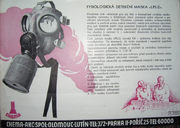The topic of this article is under research and may be incorrect in its current state.
Chema LPS (Czech: Lékařská Protiplynová Služba - Medical Anti-gas Service) was a Czechoslovak civilian gasmask developed by Chema in conjunction with the Medical Antigas Unit in Lutín (thus the name), and sold by Chema. It was in production from mid 1937 to sometime during the Second World War and after it was was reissued to early Civilni Obrana units.
Mask overview[]
The mask was made of natural rubber, and came in multiple colors – Olive green, light green, light grey, and greenish grey. Internally, the LPS was fairly simple - featuring no peripheral seal. There was a depression in the rubber to allow the user's chin to sit comfortably.

On the inside, the mask has a Tissot-tube that goes through the nose area, with an opening on the top, to defog both lenses. The mask features two eyepieces made out of double layered glass, and attached to the faceblank by metal screw bezels. Internally, a rubber lip surrounds the circumference of the bezel. The valve assembly is made out of black bakelike, and features a 42mm filter port, above which is the exhale valve, protected by a grate with the company name (CHEMA) and their logo.

Closeup of valve assembly
As with all interwar Czechoslovak masks, the intake valve is in the filter, rather than in the masks, thus the mask only has a rubber gasket to aid the seal in place of the intake valve. The valve assembly is attached with a metal wire, this wire is protected by a rubber band made from the same rubber as the mask.

Closeup of assembly
The mask utilizes a 5 point head harness made out of a brown elastic material, with the adjustment being handled by 5 buckles riveted to the faceblank, whilst all the straps have a D ring on the end, so they dont come out of the buckles, and the head harness adjustment can be easier.

Head-harness
All of these 5 straps are attached to a pentagonal head pad, made out of either green rubber, or brown leather. The two bottommost straps shared their buckle assembly with another strap which formed the neck strap. The neck strap is made from non-elasticated grey fabric.

Cut drawing of the mask, Fi: filter thread; A: exhale valve; L: Tissot-tube; F: eyepiece.
It came in two sizes, with the additional third size, the smallest one intended for kids, being it's own model the LPS-D (Czech: Dětská - children).

LPS-D
When brand new, the masks were covered in a certain chemical, which would, upon reacting with conventional gasses of those times, turn the mask purple, thus warn the user of an incoming attack, and potentionally saving life.

LPS-D advertisement featuring the pink droplets.
There was only a slight change during production which was in line with the exhale valve lid.
- Early ones had the intake and exhale valve a bit further apart, whilst the exhale valve cover received a grate

Later valve housing.
- Later ones (starting 1938) had a simpler exhale valve cover, with just 3 plastic pieces holding the middle Chema logo in

Earlier and more common valve housing.
Carrier and kit[]
The Chema LPS and LPS-D were issued with multiple different tins, varying in height and logo. The mask either came in a tall greenish grey tin with the Chema logo and name stamped onto the side and the lid just slightly shorter green canister, where, instead of stamped, the logo and a name were applied via a stencil. But all have a single carrying strap.

Chema carrying tin

The filters that the masks came with varied, but usually the masks came with either the CHF-1 (Chema Filtr-1), or the EF-2 (Eckhardt Filtr-2). These filters came wrapped in brown wax paper, and with a cardboard ring surrounding them, with a metal cap threaded on, and fabric tape covering the bottom.

Inside the CHF-1, one can see the intake valve
The kit also contained a stick of glycerine soap to help defog lenses and a cleaning cloth.
External information[]
The LPS was intended for the civilian market, and was fighting for a government contract against Fatra and their FM masks, however lost due to the fact that the LPS is more complicated, and thus more expensive to build.

LPS being used on a training.
Because of this many LPS were used for only trainings and can be found with training filters on them. These training filters were essentially weighted dummy filters that contained no filtration medium, only an intake valve. As their name implies, they were used to train civilians on how to use their gas masks correctly. Various Czechoslovak companies made these specific training filters. Chema made blue coloured ones and Fatra made golden coloured ones. They were most likely painted in these colours to ensure easy differentiation from real filters.
References[]
- Researched by: Richard Kmoch (Policajt23)
- Photos from Greenlizard56's collection
- http://www.gasmaska.stranky1.cz/nova-stranka-7899/
- http://www.gasmaska.cz/
